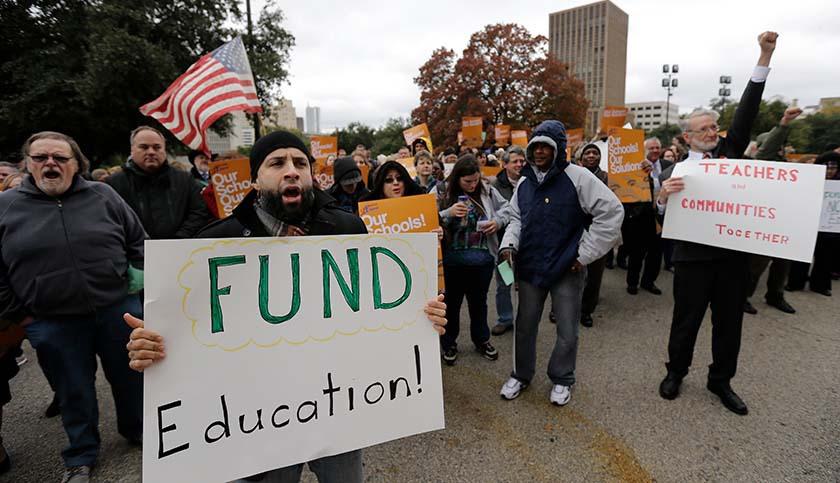Teachers' unions have long been controversial in the United States, especially now, as polarizing discussions about public education in America are front and center.
The most prominent teachers’ union in the United States is the National Education Association (NEA). By extension, the NEA has affiliates throughout the country. In Alabama, it is known as the Alabama Education Association (AEA), which has been operating in the state for over 165 years but has only existed in its current form since 1969. Paul Hubbert, head of the then-all-white Alabama Education Association, and Joe Reed, head of the all-black Alabama State Teachers Association, merged to create the modern AEA that has been a fixture in Alabama politics ever since.
At one time, the political clout of the Hubbert and Reed partnership was unmatched in Alabama, and neither shied away from using it.
However, they may have had a blueprint for achieving political power.
The AEA's parent organization, the NEA, has a history that goes back much further. It originated in 1857 as the National Teachers Association. Its stated goal was "to elevate the character and advance the interests of the profession of teaching, and to promote the cause of public education in the United States."
Membership was limited to "any gentleman who is regularly occupied in teaching in a public or private elementary school, college, or university, or who is regularly employed as a private tutor, as the editor of an educational journal, or as a superintendent of schools."
In 1866, women were permitted to join. Finally, In 1870, the organization's name was changed to National Educational Association, and membership now included "any person in any way connected with the work of education."
The late Samuel Blumenfeld, who wrote extensively on education, phonics, and illiteracy in American education, also wrote a full-length treatise on the NEA. "NEA: Trojan Horse in American Education" was first published in 1984 and dealt with the ideological foundation of the NEA, as well as its evolution into a political lobbying army.
"The NEA's dominant position in the Democratic Party has already made that party virtually a captive of the far left," Blumenfeld wrote. "And there are many liberal politicians who like what the teachers are doing because it serves their political ambitions. Meanwhile, the public schools are falling apart and academic standards are at their lowest. At least a million students emerge from high school each year as functional illiterates, thanks to the educational malpractice rampant in American public schools. The students may not be learning much, but they are getting heavy doses of propaganda from their politicized teachers."
Others are critical of the NEA's historical relationship with socialism as a political ideology, as well as its relationship with prominent socialist types such as John Dewey, Michael Harrington and Michael Chase.
The NEA's perceived friendliness with aspects of Soviet communism has also been a point of criticism. The NEA’s historically most significant rival, the American Federation of Teachers (AFT), has also been critical of the NEA in the past. However, the two have become partners in recent decades. In an undated brochure, the AFT claimed the NEA damaged legitimate democratic unions by supporting more radical ideologies.
"The Communist governments consider it a great propaganda coup to have their phony 'unions' accepted around the world as 'true representatives of the workers,'" the AFT brochure read. "When the NEA establishes ties with these groups and agrees to have official exchanges with them, it plays right into the propaganda maneuvers of these totalitarian governments. ... The NEA's cooperative activities with these so-called ‘unionists’ from Communist countries have a very negative impact on the cause of freedom and the effort to build truly free and democratic unions."
The NEA’s political arm has caused even more concern than the ideological leanings of its members. The NEA spends millions on lobbying and millions on political contributions yearly. The cash-flush nature of the NEA has made its political leanings more concerning due to the NEAs ability to lobby effectively.
According to Alex Newman, author of the book "Crimes of the Educators: How Utopians Are Using Government Schools to Destroy America's Children," the NEA "has barely bothered to conceal its leadership's affinity for communism, collectivism, socialism, humanism, globalism, and other dangerous ‘isms’ that threaten individual liberty."
In 2004, then-U.S. Secretary of Education Rod Paige decried the NEA as a "terrorist organization."
Paige later apologized for what he called a poor choice of words but insisted that the NEA's "Washington lobbyists" have been waging a campaign of "obstructionist scare tactics" against the legislation at the time called ‘The No Child Left Behind Act.’
"The NEA is probably the most intellectually dishonest organization in America," Blumenfeld writes. "It is part union, part professional organization, and part political party. Its object is to control the Congress, the fifty state legislatures, the Democratic Party, the curriculum in all the schools, public and private, and the entire teaching profession. Its interest in academics is subordinate to its radical political and social ends."
To connect with the author of this story, or to comment, email craig.monger@1819news.com.
Don't miss out! Subscribe to our newsletter and get our top stories every weekday morning










